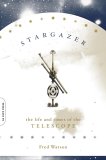Summary | Excerpt | Reviews | Beyond the Book | Readalikes | Genres & Themes | Author Bio

Critics' Opinion:
Readers' Opinion:
First Published:
Jul 2005, 360 pages
Paperback:
Jun 2006, 352 pages
 Book Reviewed by:
Book Reviewed by:
BookBrowse Review Team
Buy This Book
Chapter 1
Power Telescopes
Boldly Into The New Millenium
There is no better way to sample the state of the art of
telescope-building—nor the promise of what is to come—than by
attending an international telescope symposium, and that is where we start our
story. Such events are not everyday occurrences, but the year 2000 saw a
gathering of such significance that its deliberations will reverberate long and
loud through the annals of astronomy. It was a very large meeting, embracing no
less than thirteen separate conferences. It attracted 1,300 scientists,
engineers, directors of institutions and household-name professors, all with a
common interest in the tools of the astronomer's trade. In that broad forum, the
mysteries of the Universe met the nuts and bolts of engineering, and in the
willing hands of its participants lay the future of the telescope.
The symposium's title brashly declared its spirit: 'Power
Telescopes and Instrumentation into the New Millennium'. It took place in
Munich, during the last week in March—although the message that this was
supposed to be springtime obviously hadn't got through. By turns, the
participants endured icy winds, rain, sleet and snow on their daily journey to
the symposium sessions. Only on the last day did the Sun finally put in an
appearance.
In some ways, the symposium inside Munich's International
Congress Centre was as tumultuous as the weather outside—although its cut and
thrust were veiled in the subdued tones of academia. Let us join the
participants, and eavesdrop on their deliberations. But, before we do, we should
explore their passions a little further.
First, there was chauvinism. A rare species of chauvinism, to be
sure—but that's what it was. It concerned the different varieties of telescope
astronomers use today.
Until 1932, when Karl Jansky of the Bell Telephone Laboratories
discovered radio waves coming from space, there was only one kind of telescope.
It collected and focused ordinary visible light. It used the science of optics
to allow information to be retrieved—at first by human eyes, and then, from the
1880s, by photographic plates.
Today, there are as many different kinds of telescope as there
are varieties of natural radiation traversing the Universe. A plethora of names
identifies these ghostly emissions—gamma rays, X-rays, ultraviolet rays, visible
light, infra-red, millimetre waves (microwaves) and radio waves. Arranged in
order of wavelength, they form the electromagnetic spectrum. Somewhere near the
middle is the radiation to which our eyes are sensitive. Its wavelength is
measured in nanometres (millionths of a millimetre), and ranges from about 400
nanometres (nm) for violet light to about 700 nm for deep red. In between lies
the rainbow of the visible spectrum.
One of the heartwarming facts astronomers have brought to us in
recent years is that the Earth is constantly bathed in radiation covering the
whole electromagnetic spectrum. It comes from sources everywhere in the
Universe. Much of it never reaches the surface of the planet because it is
absorbed by the atmosphere. If you want to observe X-rays or gamma rays, for
example, you have to mount specialised telescopes on spacecraft. But for some
categories of radio and infra-red radiation—and visible light, too, of
course—the observations can be made from the ground.
To distinguish them from their more exotic cousins, telescopes
that use visible light are now called optical telescopes. They require darkness
to operate, so observing with them is always night work. They also require clear
skies. And, despite the effectiveness of the glamorous new flavours of
astronomy, optical telescopes still play a vital role in the study of the
Universe. It is the central position of visible light in the electromagnetic
spectrum—and the fact that ordinary stars emit most of their energy as visible
light—that keeps them in such high demand.
From Stargazer by Fred Watson, pages viii - x of the Prologue, and pages 1-17 of Chapter 1. Copyright Fred Watson. All rights reserved. Excerpt reproduced by permission of Da Capo Press.





The Funeral Cryer by Wenyan Lu
Debut novelist Wenyan Lu brings us this witty yet profound story about one woman's midlife reawakening in contemporary rural China.
Your guide toexceptional books
BookBrowse seeks out and recommends the best in contemporary fiction and nonfiction—books that not only engage and entertain but also deepen our understanding of ourselves and the world around us.